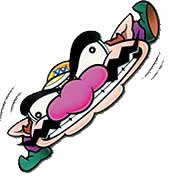A Few New Terms for the Critical Gaming Glossary
February 9th, 2014
In order to talk about games as I do, I need a specialised vocabulary of words to help me along. For several years now, I’ve been using Richard Terrell’s Critical Gaming Blog and the Critical Glossary to anchor my writing. Sometimes, though, I need to come up with my own words. Such as when I talked about player roles in Heavy Rain a few years ago. Below I’ve documented the twenty or so words I came up with to get me through my Wario Land 4 book, Game Design Companion.
Arrangement – A group of game elements arranged together, ie. a unit of level design.
Pre-fold – The first half of folded level design, where the player makes their way to the fold.
Post-fold – The second half of folded level design, where the player makes their way from the fold to the starting point.
Interaction set in context – A way of saying “an interaction and all the context that defines it”. Context being the feel of inputting the mechanic, the meanings and associations with the function, the background for the interaction, the visual and aural representation of the game elements and execution of the interaction, etc. An interaction set in context is the smallest unit of meaning in a video game.
Premise – The premise establishes the game world, its characters, and the personality and role of the avatar. By defining the avatar, the premise gives the player the information they need to inhabit the playable character and make interactions under their persona. Since the player/avatar interacts with the game world, the premise gives all individual interactions a collective purpose.
Restricted-to-Freer Practice – A model of variation whereby a level initially restricts the player’s freedom in order to ensure that they understand what is being taught, before opening up to slowly allow the player to take ownership of the content.
Bounding Box – The outer edges of level for a game set in the side-scrolling perspective. Bounding boxes often dictate the behaviour of the camera.
Form Accentuates Function – A type of form fits function where the form exaggerates the function so as to make the function more apparent to the player. (I’m thinking that this term is probably moot, but it served its purpose in the book).
Form is Familiar – Where a game element looks like something from real life so as to immediately give the player an idea about its function.
Test Teach Test – A form of education where the teacher proposes a problem to the students and has them try to solve it, observing as they fail miserably. Afterwards, the teacher introduces the lesson’s content before allowing the students to return to the original problem, now with the know-how to successfully solve it.
Fixed Linear Progression Model – A form of game progression where the player must complete the game in a linear order and has no control over progression.
Freer Linear Progression Model – A form of game progression where the player has some minor control over the way they progress through the game. For example, choosing which level to play first, where both levels must be completed.
Pure Fold – A form of folded level design where the pre-fold is the same area as the post-fold.
Reroute – A form of folded level design where the post-fold redirects the player to a different route from the pre-fold.
Skirting Along the Fold – A form of folded level design where the post-fold reroutes the player through a separated channel that is part of the pre-fold.
Environmental Upheaval – A form of folded level design where the post-fold is radically different from the pre-fold, but still uses the same base level design.
Dog Ear – A form of folded level design where the post-fold is very short.
Phases – Solid and permanent sections of a boss fight or key challenge. Once a phased is reached, the challenge cannot go backwards to an earlier phase.
Forms – Fluid and temporary sections of a boss fight or key challenge. Similar to phases, but the challenge can go backwards to an earlier form.
Linear Phase Structure – A structure used for bosses and key challenges where the boss/challenge has several phases and the player progresses through these phases linearly.
Looping Form Structure – A structure used for bosses and key challenges where the boss/challenge has multiple forms and can revert to an earlier form.
Without these words, I wouldn’t have been able to talk about Wario Land 4 much at all.
Recommended Wario Land 4 Podcasts…for the meantime
August 5th, 2013
Coincidentally, I came across two Wario Land 4-related podcasts over the past week or so. The first one is the second episode of the new volume of Retronauts and the second one is a Radio Free Nintendo podcast from last year. The Retronauts podcast is, as always, worth a listen, but I’m not so sure about Radio Free Nintendo. Although they spend a lot of time discussing the game and go into specifics—all of which is great—I feel that they read too much into their initial impressions. Every time they criticised the game because there was some part of it that they didn’t “get”, I wanted to pull my hair out. Part of critiquing games involves separating your personal biases from what the game is. Only then, once you understand what the game is, can you make sense of your opinions of the game. In other words, just because you think a game is good, bad, whatever, doesn’t necessarily mean that it is; you have to look at things a bit more objectively first. Even though Retronauts only spent around 10-15 minutes on Wario Land 4, the discussion is much more constructive than the 50 or so minutes RFN spent on it. In saying all this, though, I’ve been listening to a few RFN episodes lately and besides the Wario Land 4 discussion, I’ve rather enjoyed the other shows.
Oh, and yes, stuff is still happening with my Wario Land 4 book and you should hopefully be hearing some exciting news soon.
Wario Land 4 – Hall of Hieroglyphs Design Analysis [Video]
May 8th, 2013
This morning I was playing around with doing a video commentary piece on Anna Anthrophy’s Mighty Jill Off. I’ve been meaning to write about this game’s level design for a while, but because the game’s only playable in full screen—meaning I can’t play a bit and then type about it, or quickly stress test my comments on the fly—I never finished my article. I knew that the video wouldn’t work because I needed to have taken some notes first, but I gave it a shot anyway, just to prolong my procrastination. After not getting very far, I thought that I could do something similar on Wario Land 4, and came up with the video above. It’s pretty rough (so many “it’s important”s) and I didn’t do any preparation, but I’m still curious to know what you all think of it? Let me know in the comments.





 Game Design Companion: A Critical Analysis of Wario Land 4 - $7.99
Game Design Companion: A Critical Analysis of Wario Land 4 - $7.99 Level Design: Processes and Experiences
Level Design: Processes and Experiences Speed Boost: The Hidden Secrets Behind Arcade Racing Design - $5.99
Speed Boost: The Hidden Secrets Behind Arcade Racing Design - $5.99 Adventures in Games Analysis: Volume I - $5.99
Adventures in Games Analysis: Volume I - $5.99







